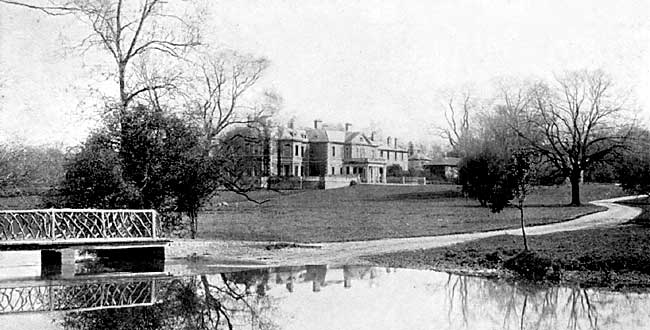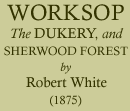< Previous | Contents | Next >
Hamlets in the parish of Worksop
Osberton

Osberton Hall, c.1900.
At the distance of three miles to the east of Worksop, and within the parish, is Osberton, the pleasant seat of Francis J. Savile Foljambe, Esq., M.P. for the Hundred of Basset-Lawe. It is a place of great antiquity, being noticed in the Conquerors survey. From that survey we learn that before the conquest there were two manors in Osberneston, as it is there written, which were of the land of the Taynes, and held by Elwine and Uluiet, paying tax for one carucate, the land being sufficient for four ploughs. At the time of the survey it was held under King William by Swan and Uluiet, who had there five sokemen, having four ploughs, and a church and 20 acres of meadow, with a considerable quantity of pasture wood. In the Confessor's time the value was 60s.; in the Conqueror's, 105.
These manors, however, appear soon to have been swallowed up by the great fee of the De Busli family, the Lords of Tickhill; for we learn from the "Testa de Nevil" that Osberton was then held by Malvesinus de Hercy, of the Countess of Augi or Eu, the then chief representative of the Bush family, by the service that he should be her Dispenser, or Steward, and the heirs of Alfreton had the land, and defended it by the like service.
This must have been before the year 1245, when the Countess appears to have forfeited her estates.
The de Alfretons were descended from one Ingram, whose name appears in Domesday as tenant of the neighbouring manor of Bilby, under Roger de Busli, as also of Norton and Alfreton in Derbyshire, from the latter of which they derived their surname. The family terminated in two heiresses in the reign of Henry III., one of whom was married to Sir W. de Caldurcis, in Chaworth; the other to Robert de Lathom, and thus she became the ancestress of the present Earls of Derby. Robert Fitz Ranalph, of this family, who was founder of Beauchief Abbey, gave the church of Osberton to the Priory of Worksop in 1183, and in 1216 it was appropriated by Walter Gray, Archbishop of York, to that monastery. The gift of Robert was confirmed by his son William, and afterwards by Thomas de Chaworth, who had inherited this portion of the de Alfreton's property. The latter also confirmed other gifts of land here made by his ancestors, especially that lying between Appelhayheved (Appleyhead) and the wood of Osberton.
The Chaworths appear to have long continued in possession of such of the property at Osberton as had not been alienated to Worksop Priory. For in 31 Henry VIII., Thomas Dynham, gentleman, claimed, among other things, the third part of the manor here of Joan Fitz William, who was part heiress of the Chaworth family.
As relates to Osberton Grange, the monastic property here, King Henry VIII., 3 July, 32 of his reign, granted it to Robert Dighton, Esq., one of the jobbers in the estates of the dissolved religious houses. In the same year Dighton had licence to alienate all houses, buildings, and hereditaments in Osberton, Hardwick, and Worksop, belonging to it, to Richard Whalley and his heirs; and all mess: lands and tenements in Osberton Grange, &c., and the houses, &c., in Osberton, &c., to William Bolles and his heirs.
It would seem that the Bolles ultimately became possessed of the whole of Osberton, where they lived for several generations in great respectability. Thomas Bolles, of this place, was Sheriff of the County, 8 Chas. I., and Samuel Bolles seems to have been an active magistrate in the time of the Commonwealth before whom, as appears from the parish register, the parishioners of Worksop were in those days married. Samuel Bolles died 1657.
From the Bolles, the estate came by marriage, to the Leeks, of Halum, and when Thoroton wrote, 1677, there were of that family "a son or two to preserve the inheritance."
The next possessors of Osberton were the family of Thornhaugh, which had been seated for several generations at Fenton in this county; and from the last of these, John Thornhaugh, Esq., who had assumed the name of Hewet, he having inherited Shireoaks and other property as a life interest under the will of the last Sir Thomas Hewet, it descended, by the marriage of his daughter, to Francis Ferrard Foljambe, Esq.
The Foljambes are a very ancient family, residing in early times in the Peak of Derbyshire, where they held offices of great trust under the Crown, and afterwards under the Duchy of Lancaster. Thomas Foljambe represented that county in Parliament, in 25th of King Edward I., and his descendants frequently attained to the same honour. They were long residents of Walton Hall, in the Parish of Chesterfield, which they inherited by marriage from the family of Loudham. Their next chief residence was at Aldwark, near Rotherham, of which they became possessed in like manner from an alliance with the ancient house of Fitz-William, of that place.
Mr. F. F. Foljambe, who was sheriff for the county of York in 1787, and afterwards member of Parliament for the same county, upon his coming into the inheritance of the Osberton estate, made it his chief residence. He greatly enlarged and improved the house, and having purchased the Scofton estate, from which Osberton is separated by the little river Ryton, he laid out the grounds, which are well wooded, so as to produce a very pleasing landscape. Mr. F. F. Foljambe died in 1814, and was succeeded by his grandson, the late much respected George Savile Foljambe, Esq., who on attaining his majority a few years afterwards, made Osberton his residence till the time of his death, which took place December 18th, 1869. Mr. G. S. Foljambe was high sheriff for the county of Nottingham in 1826. He ever bore the character of a liberal landlord and high-minded country gentleman, ready to contribute to every good work. In his earlier life he was a keen sportsman, especially in the hunting field, having for many years been owner and master of the celebrated Sandbeck pack of hounds; and though in later years he was long afflicted with the loss of sight, he is understood, even to the last, to have had a keen interest in his former pursuits. He still further improved the grounds round Osberton, by throwing open the fields between the house and the Retford Road, and by screening off the latter with a belt of trees. While the ground was being trenched preparatory to the planting of these trees, close to the third milestone from Worksop, a pot of Roman coins was found. These were small brass ones of the Constantine family; and as further evidence of the former occupation of this district by the Romans, it may be mentioned, that about two miles to the East of this spot, within property belonging to the Mason family, in December, 1802, 62 copper and 29 silver Roman coins were found. A similar find was also made at Shireoaks some years back of small brass coins, of the lower empire. The most essential improvement made by the late Mr. Foljambe to his Osberton estate consisted in the erection and endowment of a church, which has proved a great convenience to his family and tenants, who were several miles distant from the Parish Church of Worksop. The church is placed on a spot adjoining the pleasure grounds of the Hall, but on the Scofton side of the water. It is a neat fabric, in the Norman style of architecture, consisting of a tower at the west end, a nave with aisles, and a chancel, the east windows of which are enriched in stained glass, with the armorial bearings of the Foljambe family and its alliances.
The late Mr. Foljambe was twice married-first to a daughter of Sir William Milner, of Nun Appleton, Bait; secondly, to the Viscountess Milton, widow of the late Viscount Milton, and daughter of the Earl of Liverpool. By this lady he has left several children, and by the former wife an only son, Francis J. Savile Foljambe, Esq., who has succeeded to the family estates. Upon his father's death, Mr. Foljambe, who had before lived at the ancient family mansion at Aldwark, took up his residence at Osberton.
Before taking our leave of this place, we may mention that the house contains a museum, formed by F. F. Foljambe, Esq. Its principal feature is a nearly perfect collection of British birds. This collection contains a specimen of the now extinct bird, the Great Auk, and its egg. There are also some interesting antiquarian objects, such as a Roman altar, found on the family estate at Littleborough, the ancient Segelocum of Antoninus. But perhaps the most interesting article, especially as connected with the family, is the curious carved stone representing the assassination of Thomas a' Beckett, a woodcut of which is given as a tail-piece at the end of this chapter. This is stated, and not improbably, to have formed an altar piece in Beauchief Abbey. From the coats of arms which it bears, both impaled and separate, viz., sab, a bend between 6 escallops or for Foljambe; and gules, 6 fleurs de lis, 3, 2, I arg. for Ireland, there can be no doubt that it was a gift of Sir Godfrey Foljambe and his wife Avice or Anne, daughter of - Ireland, of Hazlethorn. The same arms, with half length figures of a knight and lady on a mural monument, appear in the south aisle of Bakewell Church, where Sir Godfrey founded a chantry. He died in 1375, having long been chief seneschal to the great John of Gaunt, "time-honoured Lancaster."
